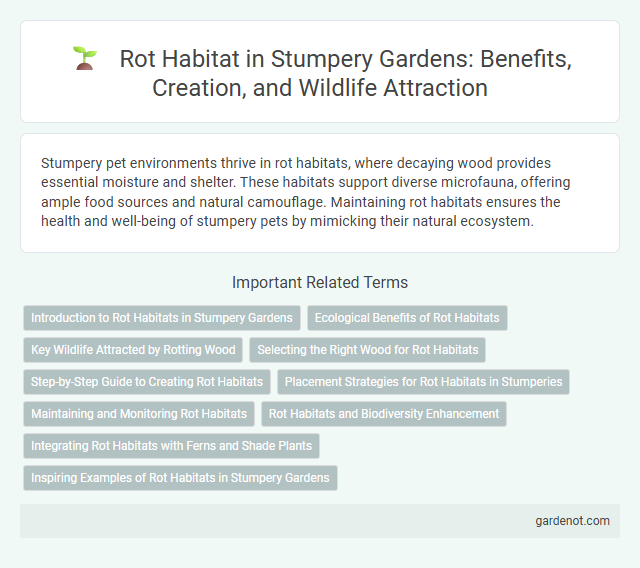Stumpery pet environments thrive in rot habitats, where decaying wood provides essential moisture and shelter. These habitats support diverse microfauna, offering ample food sources and natural camouflage. Maintaining rot habitats ensures the health and well-being of stumpery pets by mimicking their natural ecosystem.
Introduction to Rot Habitats in Stumpery Gardens
Rot habitats in stumpery gardens create essential microenvironments where decaying wood supports diverse fungi, invertebrates, and moss species. These habitats promote nutrient cycling and soil enrichment, fostering rich biodiversity within shaded, moisture-retentive areas. Integrating rot zones in stumperies enhances ecological balance and provides wildlife shelter in garden ecosystems.
Ecological Benefits of Rot Habitats
Rot habitats in stumperies provide essential microhabitats for fungi, invertebrates, and microorganisms, enhancing biodiversity by supporting decomposer communities. These environments facilitate nutrient cycling by breaking down organic matter, enriching soil fertility and promoting healthy forest ecosystems. The decay process in rot habitats also creates structural complexity, offering shelter and breeding grounds for various species, thus contributing to ecological stability.
Key Wildlife Attracted by Rotting Wood
Rotting wood serves as a vital habitat for various key wildlife species, including saproxylic beetles, woodlice, and fungi that contribute to nutrient cycling. Many bird species, such as woodpeckers, rely on decaying trees to forage for insects hidden beneath the bark. Amphibians and small mammals also use the damp, decomposing wood as shelter and breeding grounds.
Selecting the Right Wood for Rot Habitats
Choosing the right wood is critical for creating a successful rot habitat in a stumpery. Hardwood species such as oak, ash, and beech provide ideal conditions for fungi and invertebrates to thrive due to their dense structure and slow decay rate. Avoid treated or resinous woods, as they inhibit fungal growth and reduce biodiversity in the rot habitat.
Step-by-Step Guide to Creating Rot Habitats
Creating rot habitats within a stumpery involves selecting decayed logs and branches that foster beneficial fungi and decomposers vital for ecosystem health. Positioning wood in shaded, moist areas accelerates natural decay processes while enhancing biodiversity by providing shelter for insects, amphibians, and microorganisms. Regular monitoring of humidity and wood condition ensures optimal rot progression, sustaining the habitat's ecological function.
Placement Strategies for Rot Habitats in Stumperies
Rot habitats in stumperies thrive when placed in locations that balance moisture retention and airflow to encourage fungal growth while preventing excessive decay. Positioning logs and stumps in shaded, damp areas with natural leaf litter enhances decomposition processes and supports biodiversity. Optimizing placement to mimic natural forest floor conditions increases the ecological value and functionality of rot habitats within stumperies.
Maintaining and Monitoring Rot Habitats
Maintaining rot habitats requires consistent moisture levels and shaded conditions to support fungal growth and decomposer activity. Regular monitoring involves checking for signs of excessive decay or pest infestation that can disrupt the ecological balance. Integrating fungal diversity assessments helps ensure the habitat remains a thriving niche for invertebrates and nutrient cycling.
Rot Habitats and Biodiversity Enhancement
Rot habitats, such as decaying wood and leaf litter, provide essential ecosystems for a variety of fungi, insects, and microorganisms that drive nutrient cycling and soil health. Incorporating rot habitats in stumperies enhances biodiversity by creating microhabitats that support decomposers like saproxylic beetles and fungi, which in turn foster a balanced ecosystem. These habitats contribute to carbon sequestration by promoting the breakdown of organic matter and supporting diverse soil fauna critical for ecosystem resilience.
Integrating Rot Habitats with Ferns and Shade Plants
Rot habitats provide essential decomposing wood environments that foster biodiversity within shaded garden areas. Integrating rot habitats with shade-loving ferns like Athyrium and Polystichum enhances moisture retention and creates microhabitats for detritivores and fungi. This symbiotic pairing supports nutrient cycling and promotes a thriving ecosystem within a stumpery setting.
Inspiring Examples of Rot Habitats in Stumpery Gardens
Rot habitats in stumpery gardens provide essential microenvironments for decomposers like fungi, mosses, and insects, driving nutrient cycling. Inspiring examples include decaying logs from oak or cedar, which foster biodiversity by supporting woodlice, beetles, and saproxylic fungi species such as turkey tail (Trametes versicolor). Incorporating rotting stumps near shaded moist areas enhances fungal networks and enriches soil organic matter, promoting a sustainable stumpery ecosystem.
Rot habitat Infographic

 gardenot.com
gardenot.com